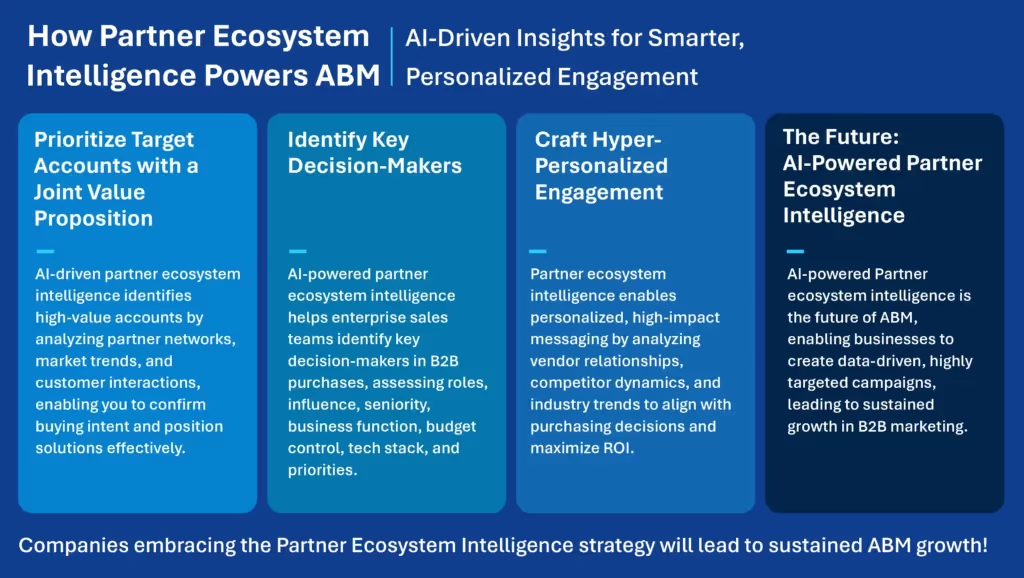Partner Ecosystem Intelligence: A Game-Changer for Modern ABM Strategies
ABM and partner-facing teams usually work in silos, following different KPIs and processes. This lack of connection makes collaboration and alignment difficult. Partner Ecosystem Intelligence is changing that by offering a network-driven view of target accounts. This helps organizations improve targeting, personalize outreach, and speed up sales cycles. Companies that have integrated ABM frameworks, including partner ecosystem intelligence, report an impressive 48% increase in revenue year-over-year due to enhanced collaboration and accountability between teams.
The Role of Partner Ecosystem Intelligence in ABM
Partner ecosystem intelligence analyzes key partnerships, alliances, and dependencies within the partner network. It helps businesses understand how target accounts interact with network partners, shaping decision-making and purchasing behavior. In ABM, where personalization and precise targeting are essential, ecosystem insights enable tailored sales and marketing strategies based on account-specific relationships. Without these insights, businesses face challenges such as unclear strategic priorities and missed opportunities due to an incomplete understanding of partner networks.

Image: How Partner Ecosystem Intelligence powers ABM using AI-driven insights for smarter, personalized engagement.
AI-powered partner ecosystem intelligence in ABM enables companies to:
- Prioritize target accounts through a joint value proposition
- Identify the key decision-makers through the partner ecosystem
- Craft engagement through the partner ecosystem intelligence
Prioritize Target Accounts Through a Joint Value Proposition
Understanding a target account’s partner network provides key insights into its technological stack, strategic priorities, and challenges. AI-driven sales intelligence refines this by analyzing market trends, customer interactions, and co-sell opportunities to identify high-value accounts.
However, even if a target account aligns with your and a partner’s offerings, it doesn’t always mean they have an immediate business need. Partner ecosystem intelligence steps in here by helping evaluate the account’s broader network of alliances to confirm buying intent. Tracking investments, product launches, and co-marketing efforts also helps pinpoint the right moment for engagement.
For example, a cloud cybersecurity company using ecosystem intelligence may discover that a major enterprise prospect is actively collaborating with cloud service partners. This insight enables the sales team to position their cybersecurity solution as a value-added enhancement to the cloud services, increasing the likelihood of deal conversion.
Identify The Key Decision-Makers Through the Partner Ecosystem
With an average of six to ten decision-makers in a B2B purchase, identifying the right contacts and approach is essential. AI-powered partner ecosystem intelligence helps enterprise sales teams assess key decision-makers based on their role, influence, seniority, business function, budget control, tech stack, and priorities.
For example, a cybersecurity services provider might typically target the Chief Security Officer or Chief Technology Officer for upselling. However, partner ecosystem intelligence reveals that an ecosystem partner has secured a contract with the target account in Europe. Given Europe’s strict GDPR, the target account has increased its focus on data compliance. As a result, the Chief Data Officer, holding greater budget control and decision-making authority, becomes the key decision-maker for engagement.
Craft Engagement Through the Partner Ecosystem Intelligence
Many companies fail to realize that generic marketing messages no longer resonate with B2B buyers. Today, executives expect high-value messaging tailored to their company’s specific pain points.
This is where partner ecosystem intelligence empowers enterprise sales and ABM teams to craft hyper-personalized, high-impact messaging. It provides insights into a target account’s current vendors, past failed partnerships, and overall partner relationships. Additionally, it reveals competitor dynamics and the key areas where the target account is competing. By analyzing relevant industry trends, ecosystem intelligence helps businesses align their messaging with the factors influencing purchasing decisions.
For example, a Europe-based data analytics company discovers that its existing client, a U.S.-based financial institution, has acquired a European finance company. Through account intelligence, they also learn that the management remains unchanged, meaning key decision-makers still hold authority. Additionally, they find out that the European finance company is investing in an AI-focused ecosystem partner that exclusively works with European businesses.
With these insights, the data analytics company can strategically approach the target account through the AI partner, addressing current pain points and highlighting seamless integration with their software. By leveraging ecosystem intelligence, they can personalize their outreach, showcasing how their solution integrates with the bank’s existing fintech partners, reducing adoption friction, and maximizing ROI.
AI-powered Partner ecosystem intelligence is the future of ABM, enabling businesses to create data-driven, highly targeted campaigns. Those who embrace ecosystem-driven ABM strategies will lead the way in B2B marketing and sustained growth.









.svg)

.svg)
.svg)
.svg)













.svg)





.svg)





.svg)
